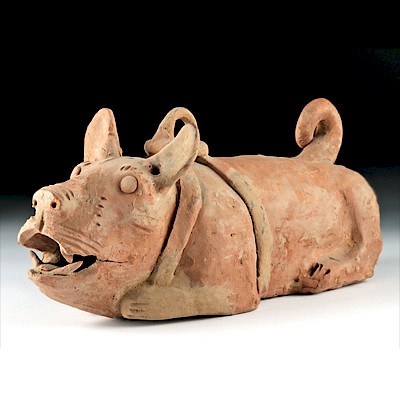Anglo-Saxon / Viking 24K Gold Filigree Bucket - 2.3 g
Lot 32
About Seller
Artemis Fine Arts
686 S Taylor Ave, Ste 106
Louisville, CO 80027
United States
Selling antiquities, ancient and ethnographic art online since 1993, Artemis Gallery specializes in Classical Antiquities (Egyptian, Greek, Roman, Near Eastern), Asian, Pre-Columbian, African / Tribal / Oceanographic art. Our extensive inventory includes pottery, stone, metal, wood, glass and textil...Read more
Estimate:
$1,500 - $2,000
Absentee vs Live bid
Two ways to bid:
- Leave a max absentee bid and the platform will bid on your behalf up to your maximum bid during the live auction.
- Bid live during the auction and your bids will be submitted real-time to the auctioneer.
Bid Increments
| Price | Bid Increment |
|---|---|
| $0 | $25 |
| $300 | $50 |
| $1,000 | $100 |
| $2,000 | $250 |
| $5,000 | $500 |
| $10,000 | $1,000 |
| $20,000 | $2,500 |
| $50,000 | $5,000 |
| $100,000 | $10,000 |
| $200,000 | $20,000 |
About Auction
By Artemis Fine Arts
Sep 13, 2018
Set Reminder
2018-09-13 10:00:00
2018-09-13 10:00:00
America/New_York
Bidsquare
Bidsquare : Ancient | Asian | Ethnographic - Fall Variety
https://www.bidsquare.com/auctions/artemis-gallery/ancient-asian-ethnographic---fall-variety-3432
Travel the world and back in time... Antiquities from Egypt, Greece, Italy and the Near East, Asian, Pre-Columbian, African / Tribal / Oceanic, Native American, Spanish Colonial, Russian Icons, Fine Art, much more! Artemis Fine Arts info@artemisfinearts.com
Travel the world and back in time... Antiquities from Egypt, Greece, Italy and the Near East, Asian, Pre-Columbian, African / Tribal / Oceanic, Native American, Spanish Colonial, Russian Icons, Fine Art, much more! Artemis Fine Arts info@artemisfinearts.com
- Lot Description
Northern Europe, Anglo-Saxon, Frankish, or Viking / Norse, ca. 6th to 11th century CE. A fascinating object, a miniature 24 karat gold basket (or bucket, or situla) with a granulated strap handle. There are bands of filigree ropework on the top and bottom of the body, forming a border with granules in repeated triangular shapes with in it around the body. On the base are further triangular granule clusters around a central granule cross motif. Granulated gold items were the ultimate symbol of wealth and status in northern and western Europe at this time. Size: .375" W x .625" H (1 cm x 1.6 cm); 2.3 grams
Like many objects from this time period, it is difficult to place this into a specific culture because there was so much movement of goods between different groups. For example, almost identical gold items have been found in the Hoen hoard, Norway's largest find of Viking gold, but the hoard contained items from the Franks, Romans, Byzantines, Anglo-Saxons, and the Arabic world. Bronze examples of these miniature situlae have been found in hoards in Vimose bog, Denmark, and Driffield, Yorkshire, England. Researchers have theorized that they represent large wooden buckets used in the world of the Franks, Anglo-Saxons, and Vikings to hold mead or ale. Those buckets were used to replenish individual drinks during feasts. These small pendants were probably symbolic of that activity, representing endless abundance.
Provenance: private New York, USA Collection
All items legal to buy/sell under U.S. Statute covering cultural patrimony Code 2600, CHAPTER 14, and are guaranteed to be as described or your money back.
A Certificate of Authenticity will accompany all winning bids.
We ship worldwide and handle all shipping in-house for your convenience.
#128424Excellent.Condition
- Shipping Info
-
All shipping is handled in-house for your convenience. Your invoice from Artemis Gallery will include shipping calculation instructions. If in doubt, please inquire BEFORE bidding for estimated shipping costs for individual items.
-
- Buyer's Premium



 EUR
EUR CAD
CAD AUD
AUD GBP
GBP MXN
MXN HKD
HKD CNY
CNY MYR
MYR SEK
SEK SGD
SGD CHF
CHF THB
THB














